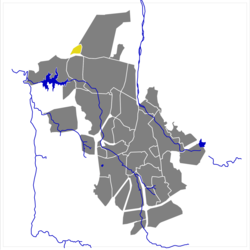Hakahana | |
|---|---|
 Shacks in Hakahana (2011) | |
 Suburb Hakahana (yellow) in the City of Windhoek | |
| Coordinates: 22°30′25″S17°6′12″E / 22.50694°S 17.10333°E | |
| Country | |
| Time zone | UTC+2 (South African Standard Time) |
Hakahana is a suburb of Windhoek, the capital of Namibia. The township is situated in the north of the town between the suburbs of Katutura, Wanaheda, and Okuryangava.
Hakahana was also a former constituency in the Khomas Region. In 2003, the constituency was split into Eastern Hakahana and Western Hakahana, both soon renamed into Tobias Hainyeko constituency and Moses ǁGaroëb constituency, respectively. [1] Hakahana means "Hurry up" in Otjiherero. [2]
